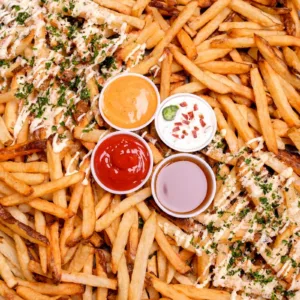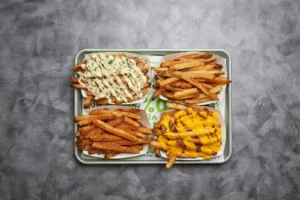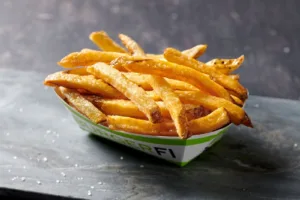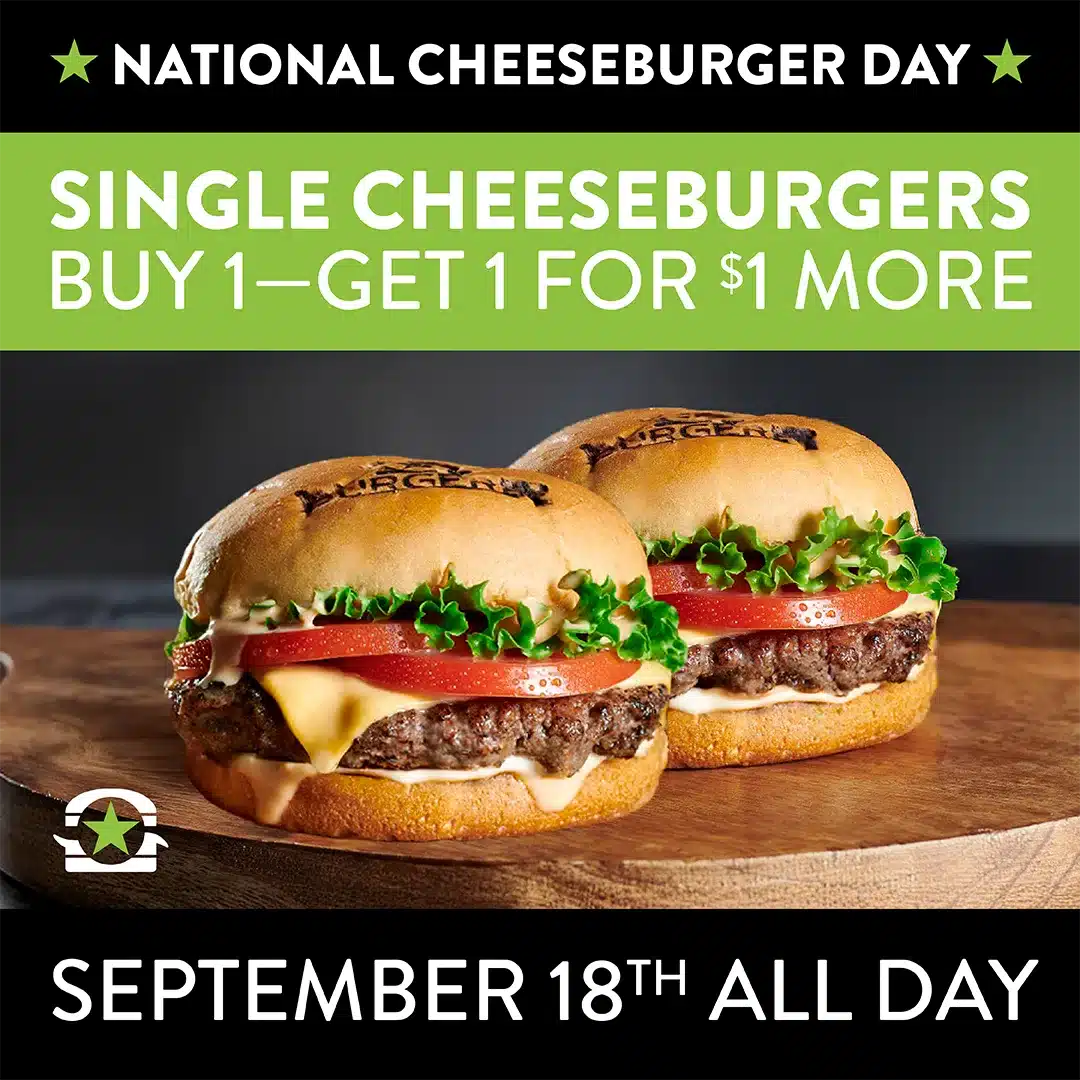French fries have become the predominant side dish of so many cuisines. These crispy, golden perfection are the ultimate crowd-pleaser, and their versatility knows no bounds. Whether they accompany an extravagant meal or stand alone as a snack, these fries hold a special place in everybody’s hearts.
This blog is a guide that unpacks the rich history and variety of French fry styles and cuts, exploring their unique appeal and cultural significance. Along with this, there are tons of practical tips to make restaurant-style crispy and flavorful fries at home.
The Origins of French Fries

The name suggests otherwise, but French fries belong to Belgian cuisine. How French Fries got their name is a story of passed-down anecdotes guided by coincidences and convenience.
In Belgium, locals traditionally fried thin slices of potatoes in the 17th century, long before “French fries” became globally recognized. During World War I, many American soldiers were staying in Southern Belgium which was filled with citizens who primarily spoke French. Upon discovering these crispy treats, the soldiers conveniently called them – French Fries.
However, some French people, do not buy into this story and consider Honoré Julien, a French chef as the founder of this recipe. Whatever may be true, one thing stays for sure, this humble potato preparation has become a global favorite and fits in seamlessly in multiple cuisines.
Cultural Adaptations
Countries worldwide have put their spin on French fries, uniquely infusing them with local flavors, techniques, and traditions. Canadians serve one of the most iconic French fry adaptations – poutine. Originating in Quebec in the late 1950s, this dish consists of crispy fries topped with fresh cheese curds and is smothered in a rich brown gravy. Originally the gravy would consist of butter, flour, and beef, but now vegan toppings of grilled mushrooms, onions, and red peppers are equally popular.
In Belgium, where French fries originated, “frieten” or “frites” are more than just a snack — they’re a cultural phenomenon. Served in paper cones with a generous dollop of mayonnaise, Belgian fries are thick-cut and double-fried for a perfect balance of crunch and softness. They even raise the flavor profile by adding different sauces like Andalouse, curry ketchup, and peanut satay.
Asians have truly leveled up the French fries with their celebrated bold flavors, spices, and sauces. Korean honey-butter fries, Chinese Schezwan sauce fries, and Indian masala fries are all delicious takes on classic French fries.
What makes French fries so popular is the versatility it brings to the table. Much like a blank canvas, it provides the perfect base to showcase a wide array of flavors and culinary creativity. If you’re feeling inspired by these cultural adaptations of French fries, there’s no cap to the innovative recipes to elevate your French fry experience.

Different Cuts of Fries Explained
Different cuts and shapes of potato cook and absorb sauces and flavors differently. While a clean-cut is famous for its balance of crispy exterior and fluffy interior, unevenly shaped fries are known for extra crunch and intense flavor hold.
Classic Cuts
Straight-cut is the gold standard for cutting fries. It is simple and original. These are a go-to choice for pairing with burgers or dipping into ketchup. A level up is the steak fry cut- thick, hearty fries that deliver on texture. These thick pieces of potato efficiently soak up sauces and gravies which work well for soupy recipes. If you prefer soft and gooey food over crunchy and dry, you’re gonna love pairing steak-cut French fries with your favorite dip.
Innovative Shapes
Shapes that increase the surface area of fries and provide the texture for maximum crunch. They also give the fries a playful twist making them popular among kids. You can always get tools to cut different types of French fries to quickly make innovative shapes like crinkle and curly cuts.
Gourmet Favorites
For someone who enjoys food like art, there are intricate ways of cooking French fries as well. Shoestring fries are very thinly cut which gives it a well-textured and crispy bite. Another luxurious fry is truffle fry which is usually baked instead of fried and seasoned with salt, pepper, and parmesan cheese. The star of the show is truffle oil which is derived from an edible fungus, truly a delicacy. The best part about French fry cuts is that there are innumerable ways of shapes and sizes you can try based on your individual preference. You just need to know the science of frying!
The Science Behind Fry Perfection

Cooking is as much science as it is art. From the shapes and sizes of fries, the type and temperature of oil, to the time of cooking and cooling, everything has a say in how the fries will turn out.
At BurgerFi, we make sure to keep two primary points in mind while making French fries:
The Role of Fry Cuts in Texture and Flavor
The type of cut impacts frying time, crispiness, and seasoning absorption. Thicker fries take more time to cook through, retain a fluffier interior, and will give you a milder flavor profile than thinner fries. Thinner fries cook faster, maximize crispiness, and carry more seasoning per bite due to their larger surface area.
So, as a rule of thumb, for milder, softer, and soupy fries, go with thicker cuts like steak fry cuts, and choose thinner cuts like shoestring cuts for crispy, dry, and spice-based fries.
Cooking Methods for Optimal Crispness
Deep-frying is the most traditional method of cooking French fries. There are two ways of doing so – Single-fry and double-fry. In the single frying method, potatoes are fried once at high heat (350°F to 375°F) until golden and crispy. This method is quick but may lack the nuanced texture of double-frying.
If you’re like most people and prefer the crispy exterior-fluffy interior duo, the double fry technique should be your go-to way of cooking French fries at home. It is the hallmark of restaurant-quality fries.
chnique, fries are first cooked at a lower temperature (around 300°F) until tender, then cooled and fried again at a higher heat. The first step of medium heat cooking cooks through the potato whereas the second flash fry gives it a golden crispy exterior. There are other ways of cooking fries as well. Baking or air frying works well without compromising on taste. The boiling and frying combination is another method that mimics the double frying method but is healthier.
Mastering French Fries at Home
There’s no fancy equipment required to make French fries at home. If you master a few steps, you can chef it up real quick!
Choose the Right Potato
Russets which are low in moisture and high in starch are said to be the ideal choice of potatoes for cooking French fries. This is why we use them for all BurgerFi fries. Waxy potatoes like Yukon Golds yield creamier results and are not well suited for crispy fries.
Experimenting with Fry Cuts
Creating a variety of fry styles at home adds to the fun of cooking French fries. From simple straight cuts to crinkle, curly, and shoestring cuts, you can try them all at home and see what suits your palate best.
The Secret to Perfect Seasoning
Seasoning makes all the difference. It can make or break the recipe. For simple classic French fries, salt can be the only condiment you use and you’ll still relish the fries. But for an extensive flavor profile, start by trying known spices like pepper, paprika, garlic onion powder, etc. You can then experiment with sauces and dips, from simple ketchup to hot sauce, barbecue dip, truffle mayo, honey mustard, and whatnot!
From thick steak fries to gourmet truffle fries, the diversity of French fry styles is the basis of their universal appeal. Hungry reading all this? Visit BurgerFi to experience our expertly crafted French fries, paired perfectly with our chef-inspired burgers. You can also find French fries nearby using BurgerFi location finder and discover why BurgerFi is a fry lover’s paradise. To enjoy it at home, order in now!
